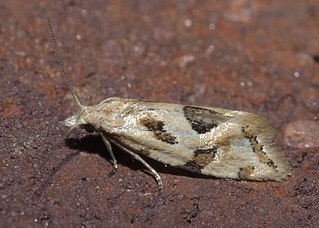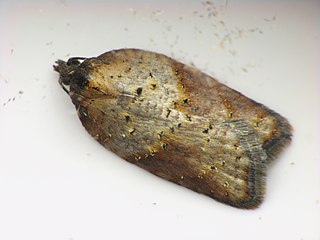
The Tortricidae are a family of moths, commonly known as tortrix moths or leafroller moths, in the order Lepidoptera. This large family has over 11,000 species described, and is the sole member of the superfamily Tortricoidea, although the genus Heliocosma is sometimes placed within this superfamily. Many of these are economically important pests. Olethreutidae is a junior synonym. The typical resting posture is with the wings folded back, producing a rather rounded profile.

The Tortricinae are the nominate subfamily of tortrix moths. Commonly referred to as leafrollers, as the larvae build shelters by folding or rolling leaves of the food plant, the tortricinae include several notable pests as well species used as biological control agents against invasive weeds.

The Archipini are a tribe of tortrix moths. Since many genera of these are not yet assigned to tribes, the genus list presented here is provisional.

Chlidanotinae is a subfamily of moths in the family Tortricidae.

Olethreutinae is a subfamily of moths in the family Tortricidae.

Eupoecilia ambiguella, the vine moth, is a moth of the family Tortricidae. It is found in Europe, China, India, Japan, Korea, Mongolia and the Russian Far East.
Agriophanes is a genus of moths belonging to the subfamily Olethreutinae of the family Tortricidae, with a single species found in India.
Centroxena is a genus of moths belonging to the subfamily Olethreutinae of the family Tortricidae.
Leguminivora is a genus of moths belonging to the subfamily Olethreutinae of the family Tortricidae.
Procoronis is a genus of moths belonging to the subfamily Olethreutinae of the family Tortricidae.

Acleris is a genus of moths belonging to the subfamily Tortricinae of the family Tortricidae. As of 2007, about 241 species were known.

Aethes is a genus of moths belonging to the subfamily Tortricinae of the family Tortricidae.
Ethelgoda is a genus of moths belonging to the family Tortricidae.
Pammenitis is a genus of moths belonging to the family Tortricidae.
Statignatha is a genus of moths belonging to the family Tortricidae.
Stephanopyga is a genus of moths belonging to the family Tortricidae.

The Atteriini are a tribe of tortrix moths.

The Tortricini are a tribe of tortrix moths.
Cydia crassicornis is a moth of the family Tortricidae. It was first described by Lord Walsingham in 1907. It is endemic to the island of Hawaii.
Józef Razowski is a Polish entomologist and lepidopterist specializing in Tortricidae. He is an honorary member of the Polish Entomological Society and a working member of the Polish Academy of Arts and Sciences (PAU). From 1988 to 1997, Razowski headed the Institute of Systematics and Evolution of Animals.










